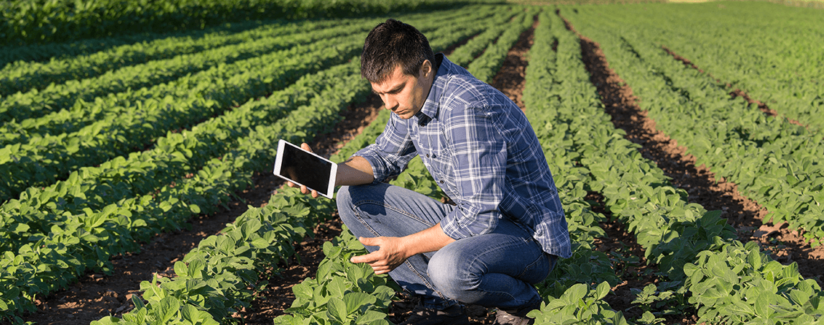
Are Farmers Using More Pesticides?
09/25/2017
Pesticides are widely used in producing food to control pests such as insects, weeds, bacteria, mold and fungus. Are the same weed and bug killers that are used on corn and soybeans the same as those used on fruits and vegetables? Are they being used at a higher rate than the previous generation of farmers? Should we be concerned that chemical residues are in the food we eat? Pesticides might make life easier for farmers, but what’s in it for me?
All good questions. We spoke with Dr. Paul Vincelli of the Department of Plant Pathology at the University of Kentucky for some answers:
Farmers are using more chemicals on crops. True or False?
Dr. Vincelli: Total pesticide use by farmers in the USA has gone up somewhat in certain crops, and down in others. Overall, however, pesticide use has been relatively stable over a period of several decades. So, I think we can say this statement is false.
We can definitely say that insecticide use has gone down. Part of the reason is crops that have been genetically modified to resist insects. In the last few years, herbicide use has been trending slightly upward. One factor driving this is the continuing emergence of weeds resistant to certain herbicides.
The organism you target with a herbicide will usually find a way to overcome it. That’s what we’re seeing with glyphosate (the active ingredient in common weed killers). It’s been a great tool for farmers but it’s not going to be effective indefinitely. Farmers are now having to use other herbicides to kill weeds that have become resistant to glyphosate and that’s why we’ve seen an uptick in herbicide use in recent years.
But even more important than total pesticide usage, it is worth pointing out that pesticides have gotten safer in recent years. This is good for farmers, farm workers, consumers and the environment.
Are the pesticides used for soybeans and corn the same as those used in fruits and vegetables?
Dr. Vincelli: Sometimes yes, sometimes no. The “active ingredient” is the component of a pesticidal product that actually controls the pest, whether it be an insect or a weed. A formulated product containing one or more active ingredients is what is actually purchased and used by farmers. A given active ingredient is almost always used on more than one crop. Sometimes a formulated product is sold for use on many crops. However, products for crops like corn and soybeans are usually distinct and sold under an entirely different trade name than those used on fruits and vegetables, even if they contain the same active ingredient.
Should we be concerned about pesticide residues in our food?
Dr. Vincelli: Our regulatory system does an excellent job of protecting our health. I’m not going to tell the moms and dads of America what they should or should not be afraid of, but pesticide residue in food is way down on my list of concerns. Exposure to pesticides in the diet is commonly thousands of times below regulatory permissible amounts.
I do note that certain recent regulatory decisions by the US-EPA have surprised me, as they do not appear to be consistent with a conservative approach to protecting public health. I’m referring to concerns about the insecticide chlorpyrifos. I’ve worked with pesticides for more than three decades and I don’t recall ever seeing a situation where a major analysis from EPA’s scientists was rejected by the EPA administration.
What are the societal benefits of using pesticides?
Dr. Vincelli: Weeds, insects, and infectious diseases can cause losses in yield or quality of the crops society depends on. Proper use of herbicides can greatly reduce the need for tillage in certain crops, which results in less soil erosion, and builds soil organic matter in some environments.
Many people care about the appearance of fruits and vegetables and pesticides help farmers grow the attractive and colorful produce you see at the grocery store. Pesticides can also help cut back on molds that produce natural toxins in food.
It’s in our best interest as consumers to have robust farming communities across the country. Pesticides that control threatening diseases and weeds help farmers remain economically viable. Working people get a paycheck once a month or every two weeks. In a given field, farmers commonly only get one chance each year to make a crop—and therefore, to pay their bills.
What does the future hold for pesticide use?
Dr. Vincelli: We need new approaches to weed control. Some farmers are using cover crops, which may sometimes help with weed control. An example would be a farmer planting grass or a cover-crop mixture in a field after the crop has been harvested. This not only crowds out weeds but also keeps soil from eroding. I’ve also heard talk of robotics that could be mounted on tractors and sense where the weeds are and mechanically whack them or pull them.
I’ve worked with pesticides for 34 years. I’m telling you we can do a lot to reduce the use of pesticides with genetic engineering. Although the acronym GMO sometimes frightens consumers, in fact, genetic engineering holds tremendous promise for reducing pesticide use. There are many, many genetic alternatives to pesticides for controlling insects and diseases. Honestly, this is why the “non-GMO” marketing trend worries me a little—because I believe we are closing off opportunities to produce food with fewer pesticides, which would be good for everyone in the food system: farmers, farm workers, food marketers, consumers, and the environment.
Weed control presents a greater challenge. Genetics offers very little for reducing farmer dependence on herbicides. There are ways to reduce the “herbicide treadmill,” but they may require that consumers pay quite a bit more for foods.
Words You Need to Know:
- Pesticide – A substance used for destroying insects, plants or other organisms harmful to cultivated plants or to animals. Pesticide is an umbrella term for substances that kill weeds, bugs or fungi. Pesticides are used in essentially all farming systems, though some systems rely on them more than others.
- Insecticide – A substance used to kill insects.
- Herbicide – A substance used to kill unwanted plant growth like weeds and grass.
- Pesticide residue – Refers to active ingredients in pesticides that may remain on or in food after they are applied to crops. The maximum allowable levels of these residues in foods are strictly regulated.
- Resistance – Weeds can become resistant when the same herbicide is used repeatedly for several years in a row. Genetic engineering can also be used to develop plants that are resistant to weed killers. This allows a farmer to spray an entire field with herbicide, leaving only the food-producing plants to grow without competing with weeds and grass for sunlight and water. And finally, “resistance” can mean that the plant has been bred or engineered to fight back against insects or diseases.
- Organic – In general, organic standards are designed to allow the use of naturally-occurring substances to control unwanted plant growth and insects while prohibiting or strictly limiting synthetic substances.
Looking for more information? Check out these resources:
Pesticides: A Look at the How and Why
Is It OK to Eat Fruits and Veggies Sprayed with Pesticides?
Are We Being Poisoned By Glyphosate?


























